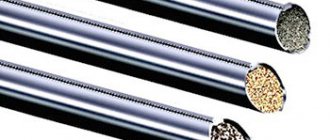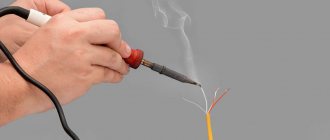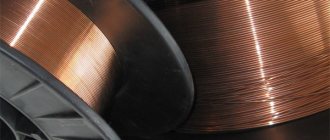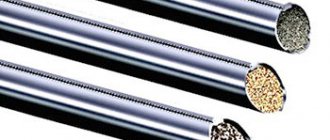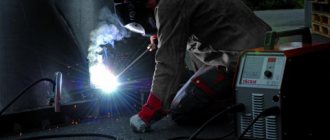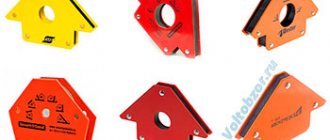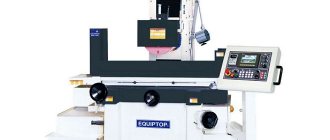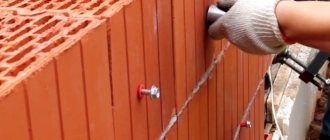Where are welding jobs needed?
It may even be that some people may need welding work in a domestic environment, but the overwhelming majority of welding work is required in a production environment, where welding is considered almost an integral function of production. When a situation arises in which it is necessary to weld metals together , the question also arises of how this work should be performed, what welding machine and materials should be used to do this, and similar issues.
There are various methods of welding metals, various consumables. They are selected depending on what metals need to be welded. If you need to weld non-ferrous or refractory metals, you should use a welding additive of a certain type.
How is the grade of material selected?
Such a question may well seriously puzzle a beginner, but if you understand everything consistently, then there is nothing overly complicated in this matter. There is a list that indicates what type of welding certain metals should be.
Application area
SV08G2S is widely used in machine-building industries, shipbuilding, for various repair work - wherever it is necessary to weld parts made of carbon steel alloys for general purposes. It is gaining popularity among owners of small auto repair shops and simply among home craftsmen.
Copper-clad wire is deservedly popular. The copper layer promotes increased conductivity due to reduced resistance at the point of contact. This property significantly increases the stability of the electric arc and increases the strength and, most importantly, durability of the suture material. This occurs due to the suppression of oxidative processes in the weld and heat-affected space.
A wide range of produced sections allows you to select the most suitable welding material for both small or thin-sheet parts, and for massive workpieces and large-sized structures. The two-millimeter model is often used for repairing small items, becoming popular in home workshops. The six-millimeter model is used in industrial settings because it requires powerful current sources.
Types of wire
The article will talk about:
- Various welding additives.
- Product labeling.
- Flux-cored wire designed for welding aluminum, which can also be used to weld titanium metal.
- For cooking steel, this is more common than other types.
- Wire that can be used to weld copper.
- Additive.
- Capable of welding cast iron and nickel alloys.
- Capable of welding stainless steel.
- Additive diameters.
Marking
An important fact for quality is its chemical composition, which is important when choosing. The composition is indicated on the product of a domestic manufacturer, provided that GOST 2246–70 is complied with; according to foreign standards, this is the AWS . In the CIS, production is quite powerful, for example, copper-plated welding sv08g2s and many other types.
Explanation of symbols on domestically produced labels:
- SV - means it is welded.
- A - this indicates that it contains nitrogen.
- B—niobium content.
- B - contains tungsten.
- G - there is manganese.
- D - contains copper.
- M—molybdenum content.
- N—nickel content.
- C - contains silicon.
- T—titanium content.
- F - vanadium.
- C - zirconium.
- X - chrome.
- Yu - aluminum.
- If there is a letter A at the end of the marking, this means that it is made of high quality steel with a minimum content of impurities.
- If there is an AA symbol at the end of the marking, this is a sign that this is the highest quality steel, and there are even fewer impurities in it than in the previous version with the A sign.
Wire SV-08G2S
If we take this view as an example, we can look point by point at what this marking means:
- SV - means that it is welding.
- 08 - this indicates that it contains alloyed elements, the mass fraction of which is 0.08%, in this case we are talking about carbon.
- G - this letter symbolizes the content of manganese in the metal from which it is made.
- 2 - means that the wire contains about 2% of the substance indicated next to this number. In this case we are talking about manganese.
- C—there is silicon in the wire. In the example under consideration there is no number after C, this indicates that there is less than 1% silicon, but more than 0.5%.
If we take SV-06Х21Н7БТ , we can conclude that it is welding, it has 0.06% carbon, 21% chromium, 7% nickel, and is alloyed with niobium and titanium.
Another example can be given: SV-08Х19Н10МЗБ , welding wire, which contains 0.08% carbon, 19% chromium, 10% nickel, 3% molybdenum, alloyed with niobium. There are cases when aluminum is marked with the symbol A: this is found in modern markings.
If you look at the marking SV-A97 , you can understand that it consists of 99.7% aluminum.
Having examined the marking SV-AK5 , you can find out that this is a wire that consists of 95% aluminum and 5% silicon. To order, you need to accurately indicate the labeling. There are situations in which it is not possible to accurately read foreign standards. GOST is always easier to read and decipher. If it is not possible to purchase a domestic manufacturer with the appropriate parameters, you need to contact a specialist who will suggest a foreign-made analogue.
What types exist
There are approximately 77 brands of all brands intended for welding various metals. They are divided into 3 types:
- Welded low-alloy, includes 6 grades containing up to 2.5% alloying elements.
- Welded alloy, includes 30 grades, contains from 2.5 to 10% alloying elements.
- Welded high-alloy, has 41 grades, contains more than 10% alloying elements.
The types are divided conditionally into parts depending on their intended use. Some types are used for welding low-alloy steels, others - for steels with a high carbon content, others - for welding various non-ferrous metals, and there are also those that are used for welding metal under submerged arcs, or copper-plated, such as welding SV08G2S.
For welding additive
The wire itself is a filler material, the only difference is that with different methods of welding metal, this filler material is fed into the metal being welded in different ways. After the start of the process of welding metal parts, a filler material of a certain diameter and composition, as required for welding a certain metal, is fed into the seam where the metal is already molten, and melts together with the two parts being welded at the point of their connection, at the edges of the metals, the function of the additive is to to fill the weld with metal.
This suggests that the filler material is the material that restores those losses that occur when metal is lost during the welding process. Instead, there are rods made of filler material, tapes, and what to use from this is seen by the specialist himself, who is trained in all the nuances when welding metals.
The main condition necessary for high-quality welding of metals is the composition of the additive as close as possible to the composition of the parts that need to be welded. You need to know what the amount of carbon is: the plasticity of the seam depends on this; sulfur and phosphorus are considered harmful to the quality of welding; their quantity should be as small as possible.
Recommendations
As an addition, we will provide you with some recommendations regarding the purchase of a welding helix. You can use these same instructions when purchasing other welding parts.
A certificate of conformity is the first request from the sales consultant before purchase. The certificate shows whether the wire actually meets the standards of the certificate.
This will save you from low-quality and counterfeit components. You should also not forget about the rare possibility of certificate forgery.
Additive melting point
This is also an important fact for achieving quality. The fact is that the melting temperature of the additive should ideally be slightly lower than the melting temperature of the elements being welded, or, in extreme cases, the same. This is required due to the fact that the elements being welded are first heated with an electric arc until the edges of the parts being welded melt, and then filler material is added, which will begin to melt a little later. If the melting temperature of the filler rod is higher than that of the base metal, the metal may burn out.
If the welding rules listed below are followed, the result will be a smooth seam, high strength and quality. If the melting temperature is not selected correctly, there is a risk of cracks in the metal.
Basic rules for quality welding:
- The additive must have the same metal thickness as the thickness of the parts being welded.
- The cleanliness of the wire plays an important role: it should be free of scale, paint, oil, and various contaminants.
- Melting of the wire should occur smoothly, without jerks; this is the task of a high-quality welding machine and, partly, a welder.
- The seam must be laid evenly, it should not have pores or cracks, the metal must be solid, without breaks.
Typically, welding metal with welding wire is carried out in an environment of carbon dioxide or argon, but there are other options for welding metal. Shielding gas is needed to protect the bath of metal being welded from oxygen, in this case the seam is much neater and smoother. When welding any non-ferrous metal, you need to select wire with the most similar metal composition.
To weld aluminum, you need wire SV-97, SV-A85, you can also select its analogues from a foreign manufacturer, for example:
- ER 1100;
- OK Autrod 1070;
- OK Autrod 18.01.
To weld low alloy steels, you need to have a lot of wire. The fact is that the demand for welding low-alloy metals is much higher than non-ferrous, high-alloy or any other types. Perhaps the most common wire is the SV-08G2S grade. Manufacturers produce this type in two versions:
- Without protective coating;
- Copper plating. This option is considered to be of higher quality, resulting in a more even arc burning, and reduced wear on the consumables of the welding machine, for example, a copper tip. The copper coating also protects the welding wire from corrosion during long-term storage.
If you use filler rods or filler wire when welding metals, you can use flux. Flux has the ability to influence the structure of the seam, the seam is even and smooth, but without flux the seam will be subject to premature destruction. Also, and this is also very important for the quality of welding of the products being welded, flux makes the welding seam more tensile, which increases the reliability and durability of the product.
Deposition coefficient indicator SV08G2S
Surfacing works are used to correct the geometric shape and dimensions of workpieces in case of defects, as well as in a planned manner - to give certain areas of the surface of the product improved physical and mechanical properties. The deposition rate is one of the most important parameters of welding materials.
It characterizes the mass of the melt deposited over a certain period of time at a certain operating current.
Weld seam when welding with wire
The specific value of the coefficient is determined:
- chemical composition of the substance;
- presence of coating (copper-plated/non-copper-plated);
- polarity of the welding current (direct/reverse);
- type of current (AC/DC).
The deposition rate is measured in grams per ampere hour and for SV08G2S cannot fall below 8.5.
The surfacing index affects the technical and economic efficiency of surfacing operations and the amount of metal loss due to spattering and evaporation.
The melting coefficient of the base metal also depends on the deposition rate, which directly affects the strength characteristics and durability of the connection.
Fluxes
The following fluxes exist:
- Borax. A very popular product for welding and tinning metals, it is often used in production;
- Boric acid;
- Sulfur;
- Silicon oxides.
Filler wire for welding is often sold in the form of coils. Before you start using it, it is recommended to straighten it, then cut it into pieces of the required length, which is chosen by the master at his discretion, depending on how it is more convenient to work. If the wire needs to be stored for a long time, it is advisable to protect it from moisture by wrapping it in waterproof paper.
Flux-cored and gas-protective flux-cored wire
To get the job done in the field or in open buildings, flux cored welding wire was developed. The seams are of high quality, mechanization of the process takes less time, and less time is spent on cleaning the metal from splashes. This type of wire has two subtypes: self-protective powder wire and gas-protective powder wire.
Gas-protective is designed for welding with a semi-automatic and automatic welding machine; low-alloy and carbon steels can be welded; welding is carried out in a protective gas environment. This can be carbon dioxide, argon, or mixtures of them. This method has a high degree of metal penetration, which allows welding of lap, corner, and butt joints even in one pass, depending on the specific case each time.
Types
There are several types of low carbon steels with:
- flux core;
- high degree of surfacing;
- flux core;
- core made of metal powder.
These are new types of welding wire, with their help it is possible to make high-quality welding of metal parts, the welding speed increases, the degree of metal spattering decreases, the deposition rate is high, and low smoke is observed during welding. This fact is also very important; the smoking effect is especially small when welding metals in an argon environment or in a protective gas environment, which consists of a mixture of gases with a high argon content.
Self-shielding flux-cored wire is also called flux-cored wire, or self-shielding. It has a core containing the necessary slag-forming and weld-protecting additives. This eliminates the use of bottled gas, which is also beneficial, since the use of bottled gas involves waste of time, transportation costs, waste of money and increased danger in the workplace, because the cylinders are under high pressure. In addition to these problems, cylinders require periodic certification.
When welding semi-automatically using gas, a protective pool is formed, the gas comes out of the nozzle and hits the molten metal of the parts being welded and creates conditions for high-quality welding. Wire, when welding occurs without the use of gas, creates protection and high-quality welding of metal in a different way. During the melting of the wire, the flux that is included in the composition melts at the same time and forms a protective layer in the welded area, which is not removed by the air flow. Thus, it is advisable to use this type of welding in open areas with high wind speeds, i.e. in field conditions.
Receiving process
Wire 08G2S is a common brand because it is universal - it is used to weld low-alloy steels and metals containing carbon. It is ideal for the work of novice welders and experienced craftsmen, sold in cassettes for professional use weighing 15 kg or more, a compact version - in 5 kg spools.
During long-term storage, the wire does not unwind, since the rows are wound tightly. For production purposes, welding wire of this marking is sold in coils from 250 kg to a weight of more than a ton. Such packaging has a beneficial effect on the wire and, when passing through the automatic feeder, does not wear out the parts due to twisting. The cost in packaging is much cheaper than wound on reels or cassettes.
Pros of self-defense powder
This wire has the following advantages:
- When welding, the electric arc is open. Thus, it is possible to monitor the process and direct it in the right direction.
- The composition of the weld seam is ideal.
- All positions for welding parts are available.
- The equipment is compact. There is no need to carry flux and gas supply equipment; there is no need to bring heavy gas cylinders with you.
- The wire has a coating that allows it to withstand the pressure of the rollers in the feed mechanism of the welding machine.
To fuse metal with an open arc, it is customary to use a wire with a diameter of two to three millimeters, to fuse the metal under a submerged arc, the wire diameter is 3.6 millimeters. To weld large-sized products, wire with a diameter of 5 millimeters is used. The technology of welding with self-shielding wire is the same as the technology of welding with filler wire, but there is a difference: the semi-automatic welding machine must have an operating mode “Without gas”, then it will be suitable for working with both types of wire.
Wire for welding steel. Wire grade SV-08G2S can be used for pipelines, various containers, and boilers.
Distinctive features
Sv08g2s wire differs from other consumable welding products in its advantages:
- it ensures the stability of the welding arc and eliminates the possibility of the electrode “sticking”;
- can be used in a wide range of welding modes;
- well suited for working with any class of welding machines;
- provides slight splashing of the melt in a gaseous environment;
- allows you to economically use copper tips and re-ignite the arc;
- provides an even, high-quality seam with good edge weldability of the parts being joined, without the presence of pores and foreign inclusions, as well as with a uniform chemical composition.
What wire to weld stainless steel with
Stainless steel must be welded semi-automatically using protective gas. The wire is made of high-alloy heat-resistant steel and contains carbon and silicon. Silicon makes the welding seam strong and of high quality. Carbon prevents the formation of intercrystalline corrosion. This wire may also contain chromium and nickel. This wire is used in the food industry, mechanical engineering, shipbuilding and other critical industries.
There are also different wire options both for welding cast iron and for welding copper, titanium, nickel alloys, they are selected according to the composition of the metal. The main rule is that the composition of the welding wire is very close to the composition of the metal being welded. You need to approach welding metals responsibly and competently, only this will ensure the expected result.
mechanical characteristics
Manufacturers are required to conduct strength tests. Each batch of welding wire 08g2s must meet the following standards:
| Diameter, mm | Tensile strength, kgf/mm2 | |
| surfacing | Welding | |
| Less than 1.5 | 89-136 | — |
| 1,6 | 89-136 | 69-101 |
| 2,0 | 79-121 | 69-101 |
| Over 2 | 69-106 | 64-96 |
The relative elongation coefficient is at least 30%. The yield strength of the product should fall in the range of 415-440 MPa. The value of the impact strength of the material measured at 40 °C is 56, and at 20 °C is 69 J/cm2.
GOST standards also standardize some other characteristics of SV08G2S.


